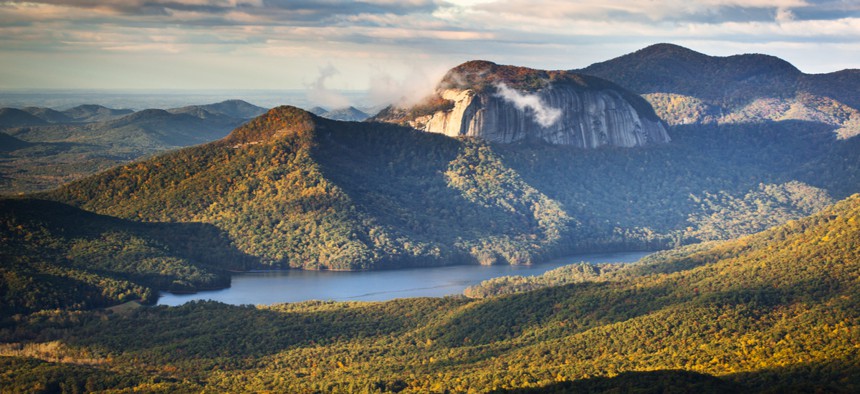State Park Debuts Virtual Reality Hike

The 5-minute video takes hikers to the top of Table Rock Mountain, a 3,000-foot peak. Shutterstock
Table Rock State Park in South Carolina now provides a 5-minute virtual hike, offered for free at the park's visitor center to anyone who can't—or doesn't want to—walk the real thing.
Visitors to Table Rock State Park in South Carolina can view waterfalls, scenic vistas and rock outcroppings along one of the state’s most strenuous hikes—all without setting foot on a trail.
The park debuted its first virtual reality hike on New Year’s Day, allowing visitors to don an Oculus headset and explore Table Rock Trail, a 3.6-mile out-and-back with beautiful views and more than 2,000 feet of elevation gain. The concept had long been on the state parks’ “wish list” and was made possible by roughly $24,000 in donations from BMW Manufacturing and the family of a Greenville County man who frequently hiked in the park, said Dawn Dawson-House, a spokeswoman for the South Carolina Department of Parks, Tourism and Recreation.
“We’re a public utility, so we have to wait until things happen financially to be able to do things on our list,” she said. “This is something that we’ve been wanting for awhile.”
The 5-minute video was produced by an outside advertising firm using about 15 hours of footage from the hiking trail, Dawson-House said. It begins at the trailhead with a view of a waterfall, then takes the user through other “iconic spots” on the hike rather than the entire trail. Stops include a historic conservation shelter, an overlook at Governor’s Rock and the trail’s end at the top of 3,124-foot Table Rock Mountain.
“It’s a 360-degree view of that spot where you’re at,” Dawson-House said. “So if you were to walk forward, you’d walk forward on the trail. If you look up, you would see the tree canopy and the sky. If you look to your left, you’d see the beauty of that particular spot.”
The virtual reality experience is housed at the park’s visitor center and is free (regular admission to the park costs $6 for adults, $3.75 for seniors and $3.50 for kids between the ages of 6 and 15). Parks officials envision the technology being used by people with limited mobility, or children, or elderly residents who used to hike the trail but find it too difficult as they grow older. But it’s open to everyone, Dawson-House said.
“It’s for anybody who can’t take this strenuous hike but still has a passion for this type of experience,” she said. “The people who manage parks want as many people as possible to enjoy the experience, and this is a way to help that.”

Parks in other states, including Alabama’s Rickwood Caverns, have deployed virtual reality technology for similar purposes, and the National Park Service partnered with Google to offer immersive videos for people unable to visit the federal properties in person. Table Rock is the first park in South Carolina to dabble in virtual reality, but Dawson-House said the state hopes to expand it to other locations as funding allows—a move she expects to take hold in more and more states.
“Because this is a growing, popular technology, I suspect that more parks either have it in their plans or are already doing it,” she said. “For us, expansion is another wish-list item. We’ll have to see how things come together.”
Kate Elizabeth Queram is a Staff Correspondent for Route Fifty and is based in Washington, D.C
NEXT STORY: Senate wants to get ahead of IoT





